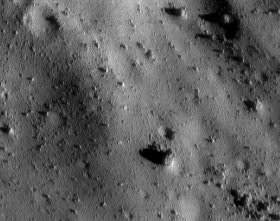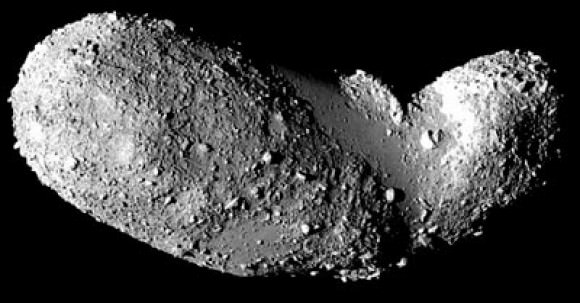[/caption]
No, it’s not the Universe Puzzle No. 3; rather, it’s an intriguing result from recent work into the strange shapes and composition of small asteroids.
Images sent back from space missions suggest that smaller asteroids are not pristine chunks of rock, but are instead covered in rubble that ranges in size from meter-sized boulders to flour-like dust. Indeed some asteroids appear to be up to 50% empty space, suggesting that they could be collections of rubble with no solid core.
But how do these asteroids form and evolve? And if we ever have to deflect one, to avoid the fate of the dinosaurs, how to do so without breaking it up, and making the danger far greater?
Johannes Diderik van der Waals (1837-1923), with a little help from Daniel Scheeres, Michael Swift, and colleagues, to the rescue.

Asteroids tend to spin rapidly on their axes – and gravity at the surface of smaller bodies can be one thousandth or even one millionth of that on Earth. As a result scientists are left wondering how the rubble clings on to the surface. “The few images that we have of asteroid surfaces are a challenge to understand using traditional geophysics,” University of Colorado’s Scheeres explained.
To get to the bottom of this mystery, the team – Daniel Scheeres, colleagues at the University of Colorado, and Michael Swift at the University of Nottingham – made a thorough study of the relevant forces involved in binding rubble to an asteroid. The formation of small bodies in space involves gravity and cohesion – the latter being the attraction between molecules at the surface of materials. While gravity is well understood, the nature of the cohesive forces at work in the rubble and their relative strengths is much less well known.
The team assumed that the cohesive forces between grains are similar to that found in “cohesive powders” – which include bread flour – because such powders resemble what has been seen on asteroid surfaces. To gauge the significance of these forces, the team considered their strength relative to the gravitational forces present on a small asteroid where gravity at the surface is about one millionth that on Earth. The team found that gravity is an ineffective binding force for rocks observed on smaller asteroids. Electrostatic attraction was also negligible, other than where a portion of the asteroid this is illuminated by the Sun comes into contact with a dark portion.
Fast backward to the mid-19th century, a time when the existence of molecules was controversial, and inter-molecular forces pure science fiction (except, of course, that there was no such thing then). Van der Waals’ doctoral thesis provided a powerful explanation for the transition between gaseous and liquid phases, in terms of weak forces between the constituent molecules, which he assumed have a finite size (more than half a century was to pass before these forces were understood, quantitatively, in terms of quantum mechanics and atomic theory).
Van der Waals forces – weak electrostatic attractions between adjacent atoms or molecules that arise from fluctuations in the positions of their electrons – seem to do the trick for particles that are less than about one meter in size. The size of the van der Waals force is proportional to the contact surface area of a particle – unlike gravity, which is proportional to the mass (and therefore volume) of the particle. As a result, the relative strength of van der Waals compared with gravity increases as the particle gets smaller.
This could explain, for example, recent observations by Scheeres and colleagues that small asteroids are covered in fine dust – material that some scientists thought would be driven away by solar radiation. The research can also have implications on how asteroids respond to the “YORP effect” – the increase of the angular velocity of small asteroids by the absorption of solar radiation. As the bodies spin faster, this recent work suggests that they would expel larger rocks while retaining smaller ones. If such an asteroid were a collection of rubble, the result could be an aggregate of smaller particles held together by van der Waals forces.
Asteroid expert Keith Holsapple of the University of Washington is impressed that not only has Scheeres’ team estimated the forces in play on an asteroid, it has also looked at how these vary with asteroid and particle size. “This is a very important paper that addresses a key issue in the mechanics of the small bodies of the solar system and particle mechanics at low gravity,” he said.
Scheeres noted that testing this theory requires a space mission to determine the mechanical and strength properties of an asteroid’s surface. “We are developing such a proposal now,” he said.
Source: Physics World. “Scaling forces to asteroid surfaces: The role of cohesion” is a preprint by Scheeres, et al. (arXiv:1002.2478), submitted for publication in Icarus.


You are all wrong! That’s a giant cheese flavoured “Wotsit”! 😉
This is a rather interesting prospect. I am a little unclear on how the Van der Waals are set up. It is the result of a dipole-dipole interaction,. An electric dipole is a 1/r^3 dependent force and two dipoles displaced from each other have a net on 1/r^6 force. That is pretty weak for large r. The question is how the dipole charge separation on molecules or dust is established.
LC
I imagine the dust on asteroids will be similar in shape to dust on the moon: jagged and spiky because there is no weather to round them off. If they are spiky, the area of contact between them will be smaller and the van der Waals forces will be lessened.
Nah. Don’t quite believe it.
It is probably due to some EU / plasma interaction where solar Birkeland currents have brutally pulverized the whole asteroid surface to dust, which in turn generated the electrostatic force.
So where is that jackass Peratt or even the veronal addicted Kristian Olaf Birkeland when you need them?
(Irony. You have to love that! Neverbeen one to go overboard with the gratitude.)
@ Nexus, It might be argued that jagged particles have more surface to surface interaction points than smooth particles.
LC
Beautifully written article, as usual, and smoothly readable (you can punctuate and spell!) but one small mistake.
You say science fiction didn’t exist mid-19th century – what about Jules Verne? ‘A Journey To The Centre Of The Earth’ and ‘From The Earth To The Moon’ were written in 1864 and 1865 respectively. Verne, and later H.G. Wells, are credited as the fathers of SF.
So when does gravitational aggregation blend into residual (force) aggregation?
Don’t tell me, it’s a sticky business.
Actually, IIRC it’s ~ 150 m and below where residuals dominate. Another win for “planetary bodies aren’t rigid states, it’s populations out of processes – take that Pluto!” view?
Mars’ dust too, if the problems of getting it out of Phoenix’s shovel is any indication.
OTOH, that really established its clingy nature, and unless I’m mistaken under suitable “dry” conditions as well, they couldn’t see the expected water film on the dust IIRC.
This is, as I understand the term, a conundrum. Perhaps it is solved this way: perfect tribologically “weathered” spheroids will end up with minimal area of contact. “Spikify” the surfaces, and you can’t do worse.
@ LBC:
I’m a little unclear myself. I’m taking this out of memory, but here goes:
– The dominant term is usually r^-4. (But I wouldn’t be surprised if r^-3 or perhaps even higher terms sometimes show up.)
– It’s, I believe, a misnomer to call it an “electrostatic” force specifically. At least on volumes on the scale of molecules those residuals are dynamical, as molecules are dynamical systems. OTOH, that complication takes the fun out of trying to estimate it.
Thanks andyf, I checked that myself and found that the article description is at least contentious.
To wit:
– Wikipedia traces science fiction way back. One of its authors (del Rey) accepts “The Epic of Gilgamesh”, which is at least from ~ date – 2000. (ISO 8601.) Gilgamesh is believed to have ruled ~ date – 2700.
– “The European brand of science fiction proper began later in the 19th century with the scientific romances of Jules Verne and the science-oriented novels of social criticism of H. G. Wells.[28]”
Consuming science fiction is a process without rigid states. It is as hard to establish artificial boundaries as if to ask when the proto-horse became a modern horse. But in any case its roots goes way back, and its modern formulation was well under way ~ date 1870, as andyf notes.
Johannes Van der Waals likely wrote his doctoral thesis ~ date 1873, when he obtained his doctorate.
It’s a bit like the stuff I find when cleaning under my bed. There is fluffy stuff which clings together in balls and there is plaster or brick dusty and small stones from the tread in my shoes. This second lot of stuff could get stuck in one of the balls of clingy stuff, but they are more likely to fall out if they are disturbed.
I think there is a missing element here. If we had random bits of clingy stuff sticking to each other, then at the surface we will have a dendrite-like structure where a flying particle sticks to the outermost stuck particle. The body of flour on earth is dense because of gravity, but the surface is pretty light. In space, you may have aggregations of fluffy particles, in which case they will mesh and tangle and generally velcro into each other as well as just attracting. This may be what Torbjorn is getting at.
This does not invalidate the paper as such. The force graph has log axes so any short-range clingy effect, which could be just Van de Waals forces, or Van de Waals forces increased a bit by dendrite tangling, will probably work in much the same way. If anything, it makes the gravitational component less significant.
Rotored vicscodynamic, annealing morphology still hot and sticky flying through a dense field of Mars Syndrome debris–like a caramel coated candy (jelly bean) rolled in crushed peanuts.
http://www.freewebs.com/writingindependence/Cydonia.htm
Notice the longitudinal asymmetry quenching asymmetrically, hence protruding the major lobe opposite–also consistent to molten formation processes of Mons Olympus mega-ejecta–a hurricane of high atmospheric rock, ash and dust.
The top coat on the pinched end could have prevented centripetal expansion there, locking up the vitreous skin of the surface where it aggregated.
Note how the major extrusion lobe lobe-sided it off the plane of longitudinal axis into a boomerang, the bigger end picking up as keep a coat as the minor lobe as the process of waxing outward from the centrode finally arrested.
I always thought Cyrano de Bergerac was considered to be the father of science fiction.
@ Torbjorn Larsson OM
@ Paul Eaton-Jones
Points taken gents. Cyrano’s could also be classed as satire.
From an astronomical standpoint, putting figures in the sky as a result of legends could be classed as science fiction. It must therefore have existed since mankind learned to write things down (or in cuneiform).
How about cave paintings, e.g. Australian aboriginal?
The electric dipole is a force F = kp/r^3, for p the dipole moment, k = constant and r the radius. For the dipole-dipole interaction of van der Vaals force, called the London force it is ~ 1/r^6.
I think this asteroid is sometimes called the “otter,” and if you look at this picture it does resemble a sea otter on it back. There is a picture as well of the other side and again it does resemble a “critter.”
Voltaire also wrote a science fiction type of novella titled “Micromegas.” His Candide has some science fiction elements to it, in particular El Dorado where all scientific knowledge had been found.
LC